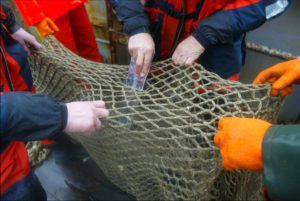New EU Action Plan to restore marine ecosystems for sustainable and resilient fisheries
IJmuiden, 25-26 March 2002. A fishing boat leaves the port of IJmuiden to go fishing in the North Sea. The nets are hauled in to recover the catch. Photo by Jan van de Vel - European Communities, 2002.
Yesterday March 21st, the European Commission published the Action Plan: Protecting and restoring marine ecosystems for sustainable and resilient fisheries as part of the set of measures aiming to improve the sustainability and resilience of the EU´s fisheries and aquaculture sector.
Towards lower impact fisheries and sustainable stocks
This action plan has been designed to reinforce the support provided by the Common Fisheries Policy´s to guarantee that healthy fish stocks and rich biodiversity levels are sustained in time in our oceans. The main actions presented aim to reduce the negative impacts of fishing activities on the marine ecosystems, especially those related to by-catch of sensitive species and its consequent effects on the marine food webs, and increase the selectivity of fishing gears.

IJmuiden, 25-26 March 2002.
Coast Guards and Official Control Inspectors set out to control fishing vessels in the North Sea.
The inspectors control the net the fishermen use. Photo by Jan van de Vel – European Communities, 2002.
Additionally, the action plan will contribute to the objectives of the recently agreed Kunming-Montréal biodiversity agreement and in delivering the EU Biodiversity 2030´s environmental targets so the EC calls all Member States to put into place adequate fisheries conservation measures to effectively manage Marine Protected Areas. These measures should embrace actions to protect fish spawning and nursery areas, reduce fish mortality rates and restore core areas for sensitive species and habitats.
On another line, the action plan aims to decrease seabed disturbances originated by fishing apparels in MPAs and the Commission calls Member States to progressively reduce mobile bottom fishing in all MPAs by 2030, as well as to forbid it in newly established MPAs. It is noteworthy that the seabed habitats comprised within MPAs play a pivotal role in the protection of marine biodiversity, as they often constitute biodiversity hotspots, and act as blue carbon reservoirs that are very needed in tackling climate change impacts.
Other measures to improve EU’s fisheries and the aquaculture sector
Together with the Action Plan: Protecting and restoring marine ecosystems for sustainable and resilient fisheries three other elements that conform the package of measures presented by the European Commission are been presented:
- a Communication on the Energy Transition of the EU Fisheries and Aquaculture sector;
- a Communication on the common fisheries policy today and tomorrowand
- a Report on the Common Market Organisation for fishery and aquaculture products.
These other measures aim to promote the use of cleaner energy sources, such as renewable and low-carbon power sources, and reduce the dependency of the fishing sector on fossil fuels, making it less vulnerable to increases in energy prices. The main goal of this energy transition is to reach climate neutrality by 2050, as it is reflected in the European Green Deal. In this context, an Energy Transition Partnership for EU Fisheries and Aquaculture it is being proposed in order to bring together all stakeholders to collectively address the challenges this transition entails.
Additionally, the Commission proposes the creation of a ‘Pact for Fisheries and Oceans”. Since the CFP constitutes the main legal framework to address the challenges that EU fisheries and the seas and, as of today, several obstacles to achieve its full implementation remain in place, this pact will bring together all stakeholders and the Commission in order to tackle them. The pact will allow to open a dialogue between the parts, build common understanding of the objectives to be achieved and help adapt the CFP where necessary.
Much of our economy depends on nature. Fisheries are quite possibly the sector where this link is most direct. Europe’s marine ecosystems and the fish, shellfish, algae, and plants that are part of them are crucial to the economic viability of fisheries. With these proposals we aim to build a sustainable relationship with our seas. The European Commission will work with local fishing communities, the aquaculture and fisheries sector and help them adopt sustainable practices, from reducing energy usage to using more selective fishing gear. As part of efforts to restore and protect nature, we also ask Member States to phase out bottom trawling in fragile areas. When we ensure the sustainability of fisheries we invest in the resilience and future of the sector and its workers. Working together, we can find the right balance and establish healthy marine ecosystems all over Europe -Frans Timmermans, Executive Vice-President for the European Green Deal – 21/02/2023
Resources of interest
For a quick overview on the Actions for sustainable and resilient fisheries, aquaculture and marine ecosystems, visit this Factsheet.
For detailed information on the four elements that conform the Commision´s package of measures to improve the sustainability and resilience of the EU’s fisheries and aquaculture sector, please visit the documents below:
EU Action Plan: Protecting and restoring marine ecosystems for sustainable and resilient fisheries
Communication on the common fisheries policy today and tomorrow
Report on the results of Common Market Organisation for fishery and aquaculture products